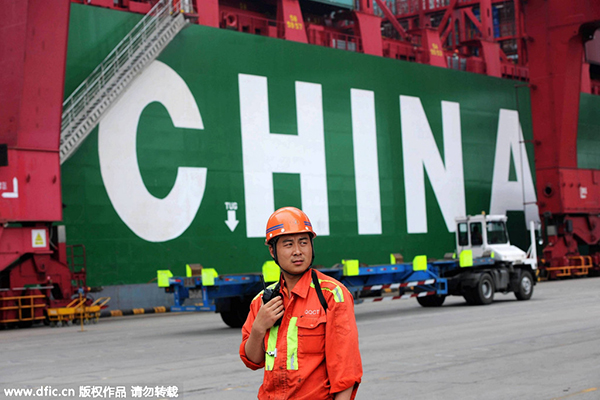China's slowdown can help other economies
Updated: 2015-12-23 08:07
By SHANG-JIN WEI(China Daily)
|
||||||||
 |
|
A stevedore works at Qingdao port in Shandong province, July 1, 2015. [Photo/IC] |
China's economic slowdown in 2015 will have important consequences for countries in the region and beyond. For most countries, even the sub-7 percent GDP growth expected this year-and in the coming years-would be a cause for celebration. After three decades of double-digit growth, however, the weakening performance of what is now the world's second-largest economy is a significant source of concern-and not just for the Chinese.
But while China's slowdown will have negative consequences for some countries, it is also creating opportunities for others. The fate of countries in the region depends on the structure of their economies-and, crucially, how they can adapt to their giant neighbor's ongoing economic transformation.
Countries that produce raw materials, such as copper, oil and minerals, for manufacturing in China are already seeing the biggest changes. China's industrial slowdown means a corresponding reduction in world demand for these commodities. Countries such as Kazakhstan and Chile, whose economies are heavily concentrated in such sectors, are finding the contraction a serious challenge.
Countries that produce intermediate goods are also feeling the pinch. Japan, for example, manufactures parts and components that are exported to China for the production of consumer electronics. In other words, its value-added exports to the world often pass through China. As a result, China's slowdown has had a noticeable effect on Japan's export performance.
But the fate of commodity and intermediate goods exporters is not set in stone. Consumers are not buying fewer smartphones, electronic toys or computers; the production of these goods will simply move from China to lower-cost producers. Vietnam, for example, has greatly increased its production and exports of smartphones and consumer electronics-an area where China used to enjoy absolute dominance-partly by attracting more foreign direct investment.
Other countries such as India and Indonesia could in principle emerge as the new export giants. But for this to happen, these countries will have to invest heavily in infrastructure and policy reforms that make their logistics and investment climate globally competitive.
Another set of countries that have felt the impact of China's rebalancing sell products and services to Chinese consumers. Despite slower growth, China's household consumption has been rising and the country's market remains one of the world's most promising. Companies that can take advantage of higher consumer spending will do well.
Thus far, countries outside Asia-such as Germany with its auto industry and the United States with its high-tech innovation-have been the primary beneficiaries of rising incomes in China. But Asia-Pacific countries have also gained ground. Singapore and Australia are taking advantage of the rising demand for high-quality education in China by expanding exports of college services. Japan is benefiting from Chinese tourists' aggressive spending habits, so much so that the phenomenon-known as bakugai-has been termed the buzzword of the year in Japan.
A third set of countries that stand to benefit comprises those that primarily compete with China. These economies can increase their global market share as China retreats from certain sectors. Precisely because of its own success, China's labor cost has risen by more than 100 percent in the last 10 years, leaving many other countries-not just Vietnam or India, but also other populous countries like Bangladesh and Myanmar-with much lower labor costs.
This means that many industries in China have lost their competitiveness, and that the Chinese economy's future growth has to come from innovation and productivity gains, rather than low-wage labor. Bangladesh, for example, has already begun to take advantage of China's withdrawal from the low-end segment of the garment market. Its production and exports have been rising rapidly, and today Bangladesh is the world's second-largest garment exporter (after China). So it's not surprising that Bangladesh and Vietnam are now two of the region's fastest-growing economies.
But the gains to be had from China's slowdown are not automatic. Because so many other countries are vying to pick up the global market share that China is shedding, the region's developing economies need to pursue a host of reforms and to invest in power, transport and urban infrastructure to make their overall investment climate competitive.
The author is chief economist at the Asian Development Bank and the head of its Economic Research and Regional Cooperation Department.
Project Syndicate
- Global health entering new era: WHO chief
- Brazil's planning minister steps aside after recordings revelation
- Vietnam, US adopt joint statement on advancing comprehensive partnership
- European border closures 'inhumane': UN refugee agency
- Japan's foreign minister calls A-bombings extremely regrettable
- Fukushima impact unprecedented for oceans: US expert

 Stars of Lijiang River: Elderly brothers with white beards
Stars of Lijiang River: Elderly brothers with white beards
 Wealthy Chinese children paying money to learn British manners
Wealthy Chinese children paying money to learn British manners
 Military-style wedding: Fighter jets, grooms in dashing uniforms
Military-style wedding: Fighter jets, grooms in dashing uniforms
 Striking photos around the world: May 16 - May 22
Striking photos around the world: May 16 - May 22
 Robots help elderly in nursing home in east China
Robots help elderly in nursing home in east China
 Hanging in the air: Chongqing holds rescue drill
Hanging in the air: Chongqing holds rescue drill
 2.1-ton tofu finishes in two hours in central China
2.1-ton tofu finishes in two hours in central China
 Six things you may not know about Grain Buds
Six things you may not know about Grain Buds
Most Viewed
Editor's Picks

|

|

|

|

|

|
Today's Top News
Liang avoids jail in shooting death
China's finance minister addresses ratings downgrade
Duke alumni visit Chinese Embassy
Marriott unlikely to top Anbang offer for Starwood: Observers
Chinese biopharma debuts on Nasdaq
What ends Jeb Bush's White House hopes
Investigation for Nicolas's campaign
Will US-ASEAN meeting be good for region?
US Weekly

|

|









